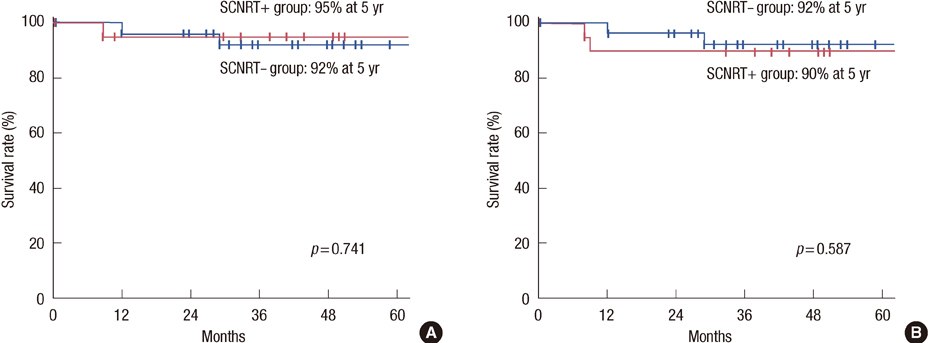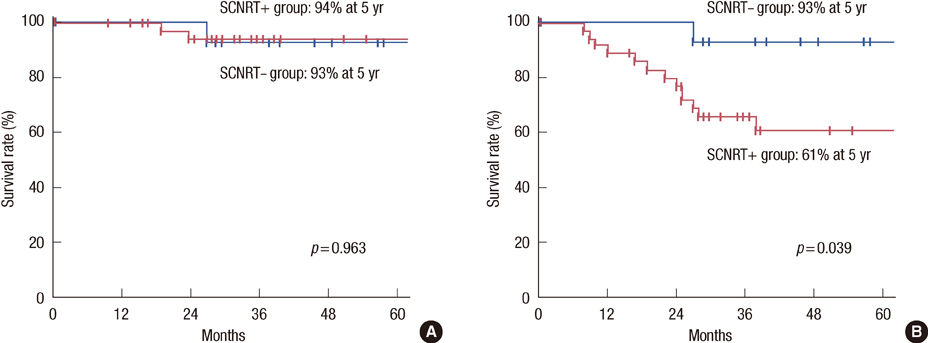J Breast Cancer.
2012 Sep;15(3):329-336. 10.4048/jbc.2012.15.3.329.
Radiation Treatment in Pathologic N0-N1 Patients Treated with Neoadjuvant Chemotherapy Followed by Surgery for Locally Advanced Breast Cancer
- Affiliations
-
- 1Department of Radiation Oncology, Korea Institute of Radiological & Medical Sciences, Seoul, Korea.
- 2Department of Radiation Oncology, Samsung Medical Center, Sungkyunkwan University School of Medicine, Seoul, Korea. wonro.park@samsung.com
- 3Department of Surgery, Samsung Medical Center, Sungkyunkwan University School of Medicine, Seoul, Korea.
- 4Division of Hematology-Oncology, Department of Medicine, Samsung Medical Center, Sungkyunkwan University School of Medicine, Seoul, Korea.
- KMID: 2286459
- DOI: http://doi.org/10.4048/jbc.2012.15.3.329
Abstract
- PURPOSE
This study evaluated the treatment results and the necessity to irradiate the supraclavicular lymph node (SCN) region in pathological N0-N1 (pN0-N1) patients with locally advanced breast cancer treated with neoadjuvant chemotherapy (NAC) followed by surgery and radiotherapy (RT).
METHODS
Between 1996 and 2008, 184 patients with initial tumor size >5 cm or clinically positive lymph nodes were treated with NAC followed by surgery and RT. Among these patients, we retrospectively reviewed 98 patients with pN0-N1. Mastectomy was performed in 55%. The pathological lymph node stage was N0 in 49% and N1 in 51%. All patients received adjuvant RT to chest wall or breast and 56 patients (57%) also received RT to the SCN region (SCNRT).
RESULTS
At 5 years, locoregional recurrence (LRR)-free survival, distant metastasis-free survival, disease-free survival (DFS), and overall survival rates were 93%, 83%, 81%, and 91%, respectively. In pN0 patients, LRR was 7% in SCNRT- group and 5% in SCNRT+ group. In pN1 patients, LRR was 7% in SCNRT- group and 6% in SCNRT+ group. There was no significant difference of LRR, regardless of SCNRT. However, in pN1 patients, there were more patients with poor prognostic factors in the SCNRT+ group compared to SCNRT- group. These factors might be associated with worse DFS in the SCNRT+ group, even though RT was administered to the SCN region.
CONCLUSION
Our study showed the similar LRR, regardless of SCNRT in pN0-pN1 breast cancer patients after NAC followed by surgery. Prospective randomized trial is called for to validate the role of SCNRT.
MeSH Terms
Figure
Reference
-
1. Overgaard M, Hansen PS, Overgaard J, Rose C, Andersson M, Bach F, et al. Danish Breast Cancer Cooperative Group 82b Trial. Postoperative radiotherapy in high-risk premenopausal women with breast cancer who receive adjuvant chemotherapy. N Engl J Med. 1997. 337:949–955.
Article2. Overgaard M, Jensen MB, Overgaard J, Hansen PS, Rose C, Andersson M, et al. Postoperative radiotherapy in high-risk postmenopausal breast-cancer patients given adjuvant tamoxifen: Danish Breast Cancer Cooperative Group DBCG 82c randomised trial. Lancet. 1999. 353:1641–1648.
Article3. Ragaz J, Olivotto IA, Spinelli JJ, Phillips N, Jackson SM, Wilson KS, et al. Locoregional radiation therapy in patients with high-risk breast cancer receiving adjuvant chemotherapy: 20-year results of the British Columbia randomized trial. J Natl Cancer Inst. 2005. 97:116–126.
Article4. Clarke M, Collins R, Darby S, Davies C, Elphinstone P, Evans E, et al. Effects of radiotherapy and of differences in the extent of surgery for early breast cancer on local recurrence and 15-year survival: an overview of the randomised trials. Lancet. 2005. 366:2087–2106.
Article5. Fortin A, Dagnault A, Blondeau L, Vu TT, Larochelle M. The impact of the number of excised axillary nodes and of the percentage of involved nodes on regional nodal failure in patients treated by breast-conserving surgery with or without regional irradiation. Int J Radiat Oncol Biol Phys. 2006. 65:33–39.
Article6. Galper S, Recht A, Silver B, Manola J, Gelman R, Schnitt SJ, et al. Factors associated with regional nodal failure in patients with early stage breast cancer with 0-3 positive axillary nodes following tangential irradiation alone. Int J Radiat Oncol Biol Phys. 1999. 45:1157–1166.
Article7. Reddy SG, Kiel KD. Supraclavicular nodal failure in patients with one to three positive axillary lymph nodes treated with breast conserving surgery and breast irradiation, without supraclavicular node radiation. Breast J. 2007. 13:12–18.
Article8. Strom EA, Woodward WA, Katz A, Buchholz TA, Perkins GH, Jhingran A, et al. Clinical investigation: regional nodal failure patterns in breast cancer patients treated with mastectomy without radiotherapy. Int J Radiat Oncol Biol Phys. 2005. 63:1508–1513.
Article9. National Institute for Health and Clinical Excellence. Early and Locally Advanced Breast Cancer: Diagnosis and Treatment: NICE Clinical Guidelines 80. 2009. London: National Institute for Health and Clinical Excellence.10. Yu JI, Park W, Huh SJ, Choi DH, Lim YH, Ahn JS, et al. Determining which patients require irradiation of the supraclavicular nodal area after surgery for N1 breast cancer. Int J Radiat Oncol Biol Phys. 2010. 78:1135–1141.
Article11. Fisher B, Brown A, Mamounas E, Wieand S, Robidoux A, Margolese RG, et al. Effect of preoperative chemotherapy on local-regional disease in women with operable breast cancer: findings from National Surgical Adjuvant Breast and Bowel Project B-18. J Clin Oncol. 1997. 15:2483–2493.
Article12. Rastogi P, Anderson SJ, Bear HD, Geyer CE, Kahlenberg MS, Robidoux A, et al. Preoperative chemotherapy: updates of National Surgical Adjuvant Breast and Bowel Project Protocols B-18 and B-27. J Clin Oncol. 2008. 26:778–785.
Article13. van der Hage JA, van de Velde CJ, Julien JP, Tubiana-Hulin M, Vandervelden C, Duchateau L. Preoperative chemotherapy in primary operable breast cancer: results from the European Organization for Research and Treatment of Cancer trial 10902. J Clin Oncol. 2001. 19:4224–4237.
Article14. Kuerer HM, Newman LA, Smith TL, Ames FC, Hunt KK, Dhingra K, et al. Clinical course of breast cancer patients with complete pathologic primary tumor and axillary lymph node response to doxorubicin-based neoadjuvant chemotherapy. J Clin Oncol. 1999. 17:460–469.
Article15. Kuerer HM, Sahin AA, Hunt KK, Newman LA, Breslin TM, Ames FC, et al. Incidence and impact of documented eradication of breast cancer axillary lymph node metastases before surgery in patients treated with neoadjuvant chemotherapy. Ann Surg. 1999. 230:72–78.
Article16. National Comprehensive Cancer Network. NCCN clinical practice guidelines in oncology: breast cancer: v.1.2012. Accessed January 20th, 2012. http://www.nccn.org/professionals/physician_gls/pdf/breast.pdf.17. Daveau C, Stevens D, Brain E, Berges O, Villette S, Moisson P, et al. Is regional lymph node irradiation necessary in stage II to III breast cancer patients with negative pathologic node status after neoadjuvant chemotherapy? Int J Radiat Oncol Biol Phys. 2010. 78:337–342.
Article18. American Joint Committee on Cancer. American Cancer Society. American College of Surgeons. AJCC Cancer Staging Manual. 2010. 7th ed. New York: Springer.19. Kaplan EL, Meier P. Nonparametric estimation from incomplete observations. J Am Stat Assoc. 1958. 53:457–481.
Article20. McGuire SE, Gonzalez-Angulo AM, Huang EH, Tucker SL, Kau SW, Yu TK, et al. Postmastectomy radiation improves the outcome of patients with locally advanced breast cancer who achieve a pathologic complete response to neoadjuvant chemotherapy. Int J Radiat Oncol Biol Phys. 2007. 68:1004–1009.
Article21. Le Scodan R, Selz J, Stevens D, Bollet MA, de la Lande B, Daveau C, et al. Radiotherapy for stage II and stage III breast cancer patients with negative lymph nodes after preoperative chemotherapy and mastectomy. Int J Radiat Oncol Biol Phys. 2012. 82:e1–e7.
Article22. Huang EH, Tucker SL, Strom EA, McNeese MD, Kuerer HM, Buzdar AU, et al. Postmastectomy radiation improves local-regional control and survival for selected patients with locally advanced breast cancer treated with neoadjuvant chemotherapy and mastectomy. J Clin Oncol. 2004. 22:4691–4699.
Article23. Huang EH, Strom EA, Perkins GH, Oh JL, Chen AM, Meric-Bernstam F, et al. Comparison of risk of local-regional recurrence after mastectomy or breast conservation therapy for patients treated with neoadjuvant chemotherapy and radiation stratified according to a prognostic index score. Int J Radiat Oncol Biol Phys. 2006. 66:352–357.
Article24. Min SY, Lee SJ, Shin KH, Park IH, Jung SY, Lee KS, et al. Locoregional recurrence of breast cancer in patients treated with breast conservation surgery and radiotherapy following neoadjuvant chemotherapy. Int J Radiat Oncol Biol Phys. 2011. 81:e697–e705.
Article
- Full Text Links
- Actions
-
Cited
- CITED
-
- Close
- Share
- Similar articles
-
- Efficacy and safety of sequential neoadjuvant chemotherapy and short-course radiation therapy followed by delayed surgery in locally advanced rectal cancer: a single-arm phase II clinical trial with subgroup analysis between the older and young patients
- Neoadjuvant Chemotherapy with Docetaxel and Adriamycin in Breast Cancer; Clincopathologic Factors Influencing to Response Rate
- Correlation between Tumor Response to Neoadjuvant Chemotherapy and Patient Outcome in Breast Cancer
- Result of Neoadjuvant Chemotherapy, Surgery and Radiation Therapy in Locally Advanced Breast Cancer
- Neoadjuvant Chemotherapy in Asian Patients With Locally Advanced Gastric Cancer



